First impressions: Powershift ditched for JCB’s TM280S telehandler
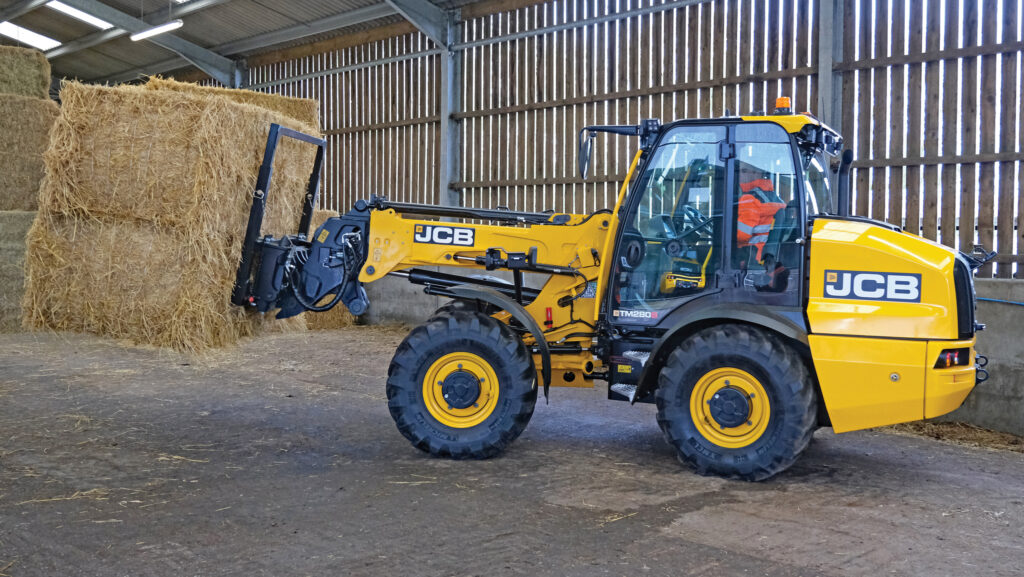 JCB TM280s
JCB TM280s Short of a pivot-steer telehandler to sit between its compact TM220 and heavier-duty TM320 Telemaster, JCB decided to build one. Well, two, actually.
The fruits of this endeavour are the TM280 and pokier TM280S which, rather than being spiced-up or sedated versions of the above, have been developed largely from scratch.
This approach has allowed engineers to keep proportions neat – 2.59m high and 2.1m wide on 420mm tyres – while eking out the maximum potential lift and reach.
See also: On test: JCB’s new TM420S pivot-steer telehandler
As a result, they promise to be significantly handier around tight yards and low buildings than their bigger siblings, and yet still offering decent lifting ability.
New they might be, but the inspiration had to come from somewhere. So, rather than beef up the lighter engineering of the TM220, designers set about slimming down the TM320.
By mounting the engine and transmission lower in the chassis and fitting narrower axles, they were able to deliver compact proportions while retaining a lift capacity of 2.75t and lift height of 4.8m – 450kg and 400mm less than a TM320.
An added perk of the repackaging work is a lower engine cover, which gives improved visibility to the rear.
Two power options
The engine is the same 4.8-litre, four-cylinder Dieselmax used by larger TM models, albeit with slightly less zesty performance.
In the regular 280, this has been tuned to deliver a modest 109hp/516Nm, with the “S” version cranked up to 130hp/550Nm, putting it on par with the standard TM320. Both have wide-core radiators for efficient cooling, as well as an optional reversing fan.
Up to this point, the 280 models seem little more than a TM320 that has been shrunk in the wash. But the transmission is where they veer off on an entirely different tack.
High-tech transmission
Rather than an eight-speed powershift, the 280 is fitted with a single-speed hydrostatic and the “S” has a hybrid setup, similar to that found in the firm’s rigid handlers.
The former is best for yard work, where its lower engine power is ample for most tasks and the hydrostat offers smooth, linear acceleration, as well as useful low-down power for shifting muck.
Top speed is just 30kph, though, so it’s only really suited to short sorties on tarmac.
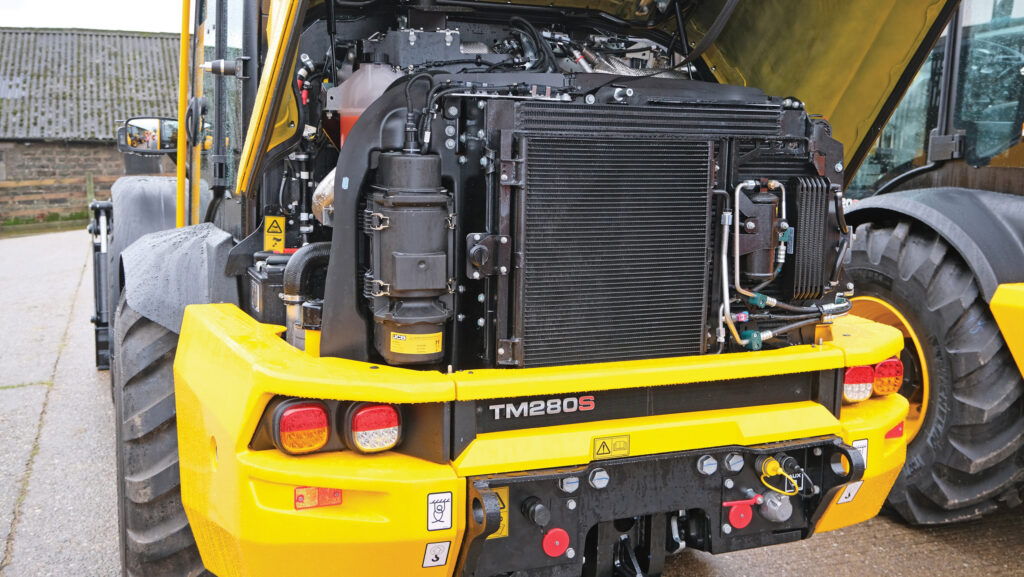
The 4.8-litre DieselMax delivers 109hp on the TM280, 130hp on the S © James Andrews
For an extra £5,000, the DualTech VT promises a far broader skill set. Slick hydrostatic drive is delivered at working speeds of up to 25kph, beyond which a direct mechanical driveline kicks in to propel it up to 40kph.
This means it offers all the merits of the straight hydrostatic, as well as better on-road performance and the ability to tow weighty trailers.
The key difference between this DualTech and the version fitted in the Loadall is that it is configured with a longitudinal, rather than transverse, orientation to the engine.
Nevertheless, both work in the same way, switching automatically from hydrostatic to direct mechanical drive with a propshaft between the engine-mounted pump and transfer gearbox bypassing the hydraulic motor.
In the yard, the single-speed hydrostatic and DualTech are almost identical to drive, so the decision on which to buy comes largely down to whether there’s enough road and towing work to warrant the extra outlay.
Regardless of which buyers opt for, power is transferred via limited slip differentials front and rear to help maintain traction in slippery conditions.
Flexible driving modes
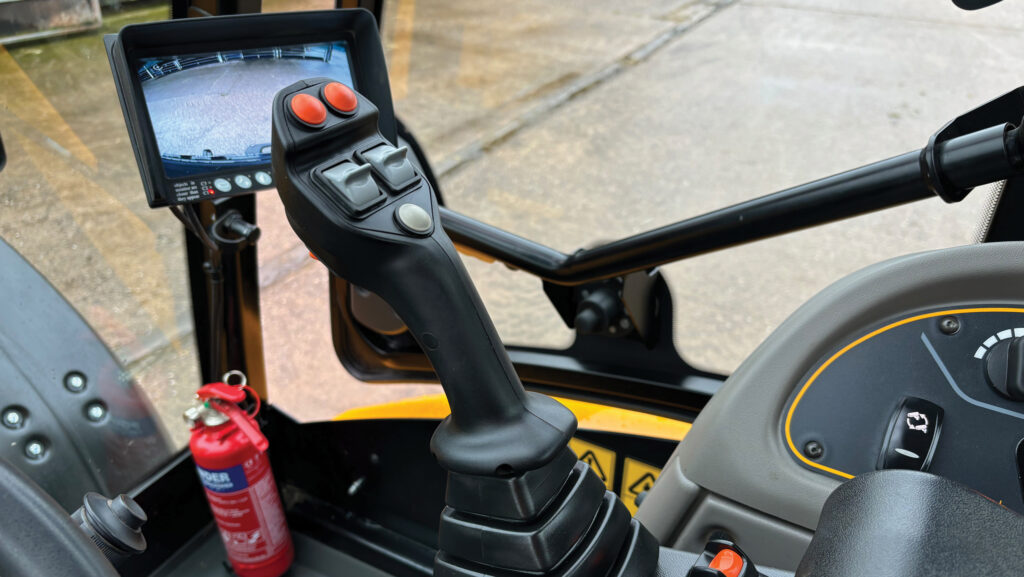
In typical JCB fashion, controls are simple and straightforward © James Andrews
Another advantage of the hydrostatic element in these transmissions is their ability to isolate engine revs from forward speed – something that can’t be done on larger powershift TM models.
This is achieved by choosing “snail” mode on the joystick, after which high revs can be selected to give peak hydraulic flow for running implements such as bedding machines, root chopping buckets or sweeper brushes.
Drivers can then adjust speed from 0-20kph as they see fit, using the right pedal.
Another two modes offer further opportunity to adjust driving characteristics.
Selecting “tortoise” permits the engine to rev freely to give greater hydraulic flow, while allowing drivers to limit top speed – the idea being that it gives peppier performance for repetitive high-load tasks such as mucking out sheds.
Meanwhile, “hare” gets the engine and transmission working together at low revs to reduce fuel use.
On top of this, there’s a free-roll neutral function that removes the hydrostatic braking function to ape the driving characteristics of torque converter machines.
The result is that the loader will roll up to a silage clamp or stack of bales, rather than drivers having to keep their foot on the accelerator.
Other features include cruise control and an electric park brake – standard on the “S”, optional on the regular 280 – that can be set to engage and disengage automatically when the machine comes to a stop on steep ground.
Spacious cab
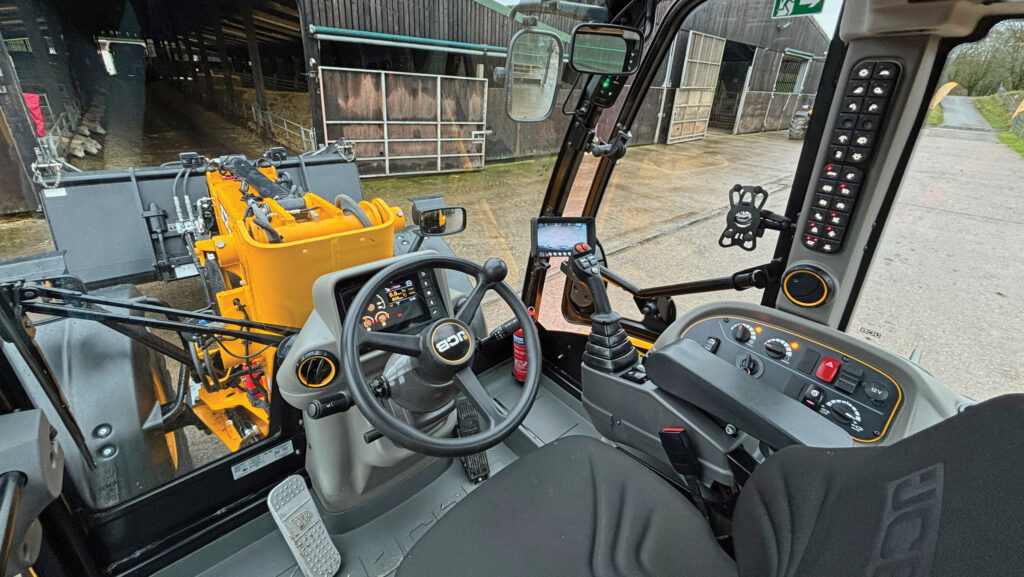
Easy-access cab is identical to that of the popular TM320 © James Andrews
It’s business as usual with the cab, which has filtered down from larger machines.
This is suitably spacious and available in a trifecta of trim levels, with varying levels of equipment. Access is made easy thanks to the tilting steering column, and the TM280’s shorter stature means there’s less of a leap to get up in there.
Visibility is good all round and the seating position is comfortable enough.
Although, the legs-akimbo stance required to reach the accelerator and brake pedal will no doubt seem odd to anyone segueing from a tractor loader or rigid telehandler.
A rear-view camera is fitted as standard, and it comes with a decent array of work lights. However, buyers do have to fork out extra if they want LEDs.
Boom and hydraulics
The boom shares its construction with the TM320, which is no bad thing.
This should be more than tough enough for the loads thrown its way, and the graphite-impregnated bronze bushes should help it stand the test of time.
These only need to be greased at 500-hour intervals – the same as the engine oil – so they won’t suffer too greatly in the hands of operators that are allergic to grease guns.
A 140-litre/min piston pump delivers decent cycle times and the boom suspension system gives a smooth and stable ride on rough terrain.
In addition, the 280s have the option of single- or twin-auxiliary boom end services, both of which have a pressure-release system that makes it easier to connect and remove pipes.
Neat rear hitch
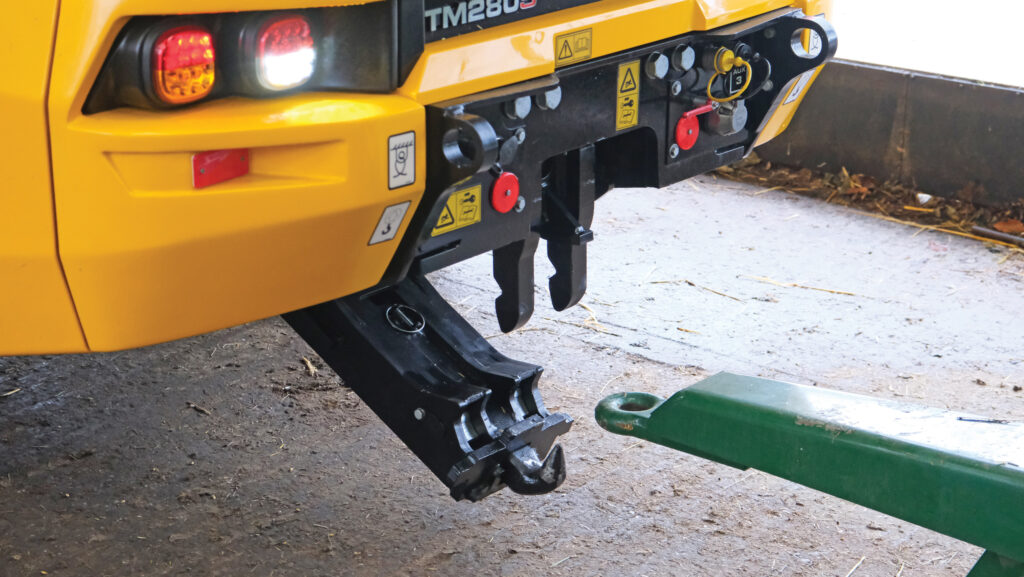
Pick-up hitch on JCB TM280 © James Andrews
Another feature that sets these machines apart from other TMs is their neat hide-away pick-up hitch.
This optional extra is integrated into the chassis, so it doesn’t hamper approach and departure angles when not in use. Plus, operators don’t have to fold it down manually, unlike the retrofit Bill Bennet setup used on the TM320.
The unit has also been designed with the drawbar hook to be as close as possible to the loader’s rear axle, thus improving stability.
This makes it impossible to see with the naked eye, but there’s a carefully positioned under-belly camera feeding into the in-cab display which neatly solves that problem.
Farmers Weekly verdict
For anyone that’s been hankering after a TM320, but hasn’t had the yard space or budget to accommodate one, the TM280 and TM280S have provided the answer.
The engine is the same, as is the cab, so they simply provide a little less lifting capacity and reach in return for smaller proportions and lower price tags.
Transmissions are a different story, though, with pure hydrostatic and hydro-mechanical stepping in instead of conventional powershifts.
In many ways they’re an upgrade, providing greater flexibility for running powered implements while, in the case of the DualTech, giving no penalty on the road or when towing. So much so, that we wouldn’t be surprised to see this option appear on the TM320.
However, with purely hydrostatic drive at lower speeds, silage clamp performance isn’t likely to be as good as the old
mechanical powershift with its ultra-efficient torque lock.
JCB TM280 and TM280S specs |
|||
|
|
TM280 |
TM280S |
|
|
Engine |
Four-cylinder, 4.8-litre JCB DieselMax 448 |
||
|
Max power |
109hp |
130hp |
|
|
Max torque |
516Nm |
550Nm |
|
|
Transmission |
Single-range hydrostatic |
Hydro-mechanical DualTech VT |
|
|
Top speed |
30kph |
40kph |
|
|
Lift capacity |
2.75t |
||
|
Lift height |
4.8m |
||
|
Hydraulics |
140 litres/min |
||
|
List price |
£110,429 |
£115,640 |
|

